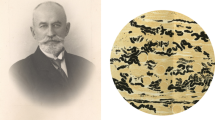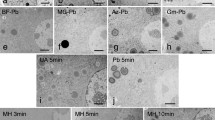Summary
The three steps of the sulphide silver method have been examined: 1) Transformation of metals to metal sulphides; 2) Fixation and embedding or freezing of the tissue for sectioning; and 3) Deposition of metallic silver on the metal sulphides in a physical developer. Based on the results, a revised method is described and discussed. It is particularly important 1) To maintain a sufficient but low concentration of sulphide ions during the perfusion; 2) To avoid using oxidating or acid fixatives; 3) To ensure low temperatures while embedding in paraffin or during polymerization of Epon; and 4) to use a slow-acting physical developer. Examples of the metal sulphide pattern from various tissues are presented.
Similar content being viewed by others
References
Bahr CF (1954) Osmium tetroxide and ruthenium tetroxide and their reactions with biologically important substances. Exp Cell Res 7:457–479
Brun A, Brunk U (1970) Histochemical indication for lysosomal localization of heavy metals in normal rat brain and liver. J Histochem Cytochem 18:820–827
Brunk U, Skjöld G (1967) The oxidation problem in the sulphide-silver method for histochemical demonstration of metals. Acta Histochem 27:199–206
Brunk U, Brun A, Skjöld G (1968) Histochemical demonstration of heavy metals with sulfide-silver method. A methodological study. Acta Histochem 31:345–357
Danscher G (1976) Heavy metals in the hippocampal region. Some aspects of localization, function and content with special emphasis on the effect of chelating agents. Thesis, Aarhus, pp 1–36
Danscher G (1981a) Localization of gold in biological tissue. A photochemical mthod for light and electronmicroscopy. Histochemistry 71:81–88
Danscher G (1981 b) Light and electronmicroscopic localization of silver in biological tissue. Histochemistry (in press)
Danscher G, Fredens K (1972) The effect of oxine and alloxan on the sulfide silver stainability of the rat brain. Histochemie 30:307–314
Danscher G, Haug F-MŠ (1971) Depletion of metal in the rat hippocampal mossy fiber system by intravital chelation with dithizone. Histochemie 28:211–219
Danscher G, Zimmer J (1978) An improved Timm sulphide silver method for light and electron microscopic localization of heavy metals in biological tissues. Histochemistry 55:27–40
Danscher G, Haug F-MŠ, Fredens K (1973) Effect of diethyldithiocarbamate (DEDTC) on sulphide silver stained boutons. Reversible blocking of Timm's silver stain for “heavy” metals in DEDTC treated rats (light microscopy). Exp Brain Res 16:521–532
Danscher G, Fjerdingstad EJ, Fjerdingstad E, Fredens K (1976) Heavy metal content in subdivisions of the rat hippocampus (zinc, lead and copper). Brain Res 112:442–446
Danscher G, Schrøder HD (1979) Histochemical demonstration of mercury induced changes in rat neurons. Histochemistry 60:1–7
Doré JL, Vernon-Roberts B (1976) A method for the selective demonstration of gold in tissue sections. Med Lab Sci 33:209–213
Fredens K, Danscher G (1973) The effect of intravital chelation with dimercaprol disodium edetate, 1–10-phenantroline and 2,2-dipyridol on the sulfide silver stainability of the rat brain. Histochemie 37:321–331
Gallyas F (1979) Light insensitive physical developers. Stain Technol 54:173–176
Haug F-MŠ (1967) Electron microscopical localization of the zinc in hippocampal mossy fibre synapses by a modified sulfide procedure. Histochemie 8:355–368
Haug F-MŠ (1973) Heavy metals in the brain. A light microscope study of the rat with Timm's sulphide silver method. Methodological considerations and cytological and regional staining patterns. Adv Anat Embryol Cell Biol 47:1–71
Haug F-MŠ, Danscher G (1971) Effect of intravital dithizone treatment on the Timm sulphide silver pattern of rat brain. Histochemie 27:290–299
Ibata Y, Otsuka N (1969) Electron microscopic demonstration of zinc in the hippocampal formation using Timm's sulfide-silver technique. J Histochem Cytochem 17:171–175
Kodousek R (1963) Carnoy-Natriumsulfidgemisch als Fixierungsmittel bei der Sulfid-Silbermethode nach Timm. Acta Histochem 15:386–388
Kóssa J (1901) Über die im Organismus künstlich erzeugbaren Verkalkungen. Beitr Path Anat 29:163–202
Krajian AA (1933) A modification of Dieterlés method for demonstrating spirochaita pallida in single microscopic sections. Am J Syph 17:127–132
Kemp K, Danscher G (1979) Multi element analysis of the rat hippocampus by proton induced X-ray emission spectroscopy (phosphorus, sulphus, chlorine, potassium, calcium, iron, zinc, copper, lead, bromine, and rubidum). Histochemistry 59:167–176
Liesegang RE (1911) Die Kolloidchemie der histologischen Silber-Färbungen. Kolloid Beihefte 3:1–46
Liesegang RE (1928) Histologische Versilberungen. Z Wiss Mikrosk 45:273–279
Liesegang RE, Rieder W (1921) Versuche mit einer “Keimmethode” zum Nachweis von Silber in Gewebsschnitten. Z Wiss Mikrosk 38:334–338
Mayer A (1850) In: Henriqus V, Okkels H (1929) Histochemische Untersuchungen über das Verhalten verschiedener Eisenverbindungen innerhalb des Organismus. Biochem Z 210:198–224
Müller A, Geyer G (1965) Elektronenmikroskopischer Schwermetallnachweis in den Prosekretgranula der Panethschen Zellen. Acta Histochem 21:404–405
Pearse AGE (1960) Histochemistry. Theoretical and applied. 1st ed. J & A Churchill, London
Pearson AA, O'Neil SL (1946) A silver gelatin method for staining nerve fibers. Anat Rec 95:297–301
Peters A (1955) A general purpose method of silver staining. Q J Microsc Sci 96:323–328
Pihl E (1967) Ultrastructural localization of heavy metals by a modified sulfide-silver method. Histochemistry 10:126–139
Pihl E, Falkmer S (1967) Trials to modify sulfido-silver method for ultrastructural tissue localization of heavy metals. Acta Histochem 27:34–41
Pihl E (1968) Recent improvements of the sulfide-silver procedure for ultrastructural localization of heavy metals. J Microsc 7
Phillips FCC (1894) Untersuchungen über die chemischen Eigenschaften von Gasen. Erscheinungen bei der Oxydation von Wasserstoff und Kohlenwasserstoffen. Z Anorg Chem 6:213–228
Querido A (1947) Gold intoxication of nervous elements on the permeability of the blood-brain-barrier. Acta Psychiatr Neurol 22:7–151
Roberts WJ (1935) A new procedure for the detection of gold in animal tissue. Proc R Acad Amsterdam 38:540–544
Timm F (1958) Zur Histochemie der Schwermetalle, das Sulfid-Silber-Verfahren. Dtsch Z Gesamte Gerichtl Med 46:706–711
Timm F (1962a) Histochemische Lokalisation und Nachweis der Schwermetalle. Acta Histochem Suppl 3:142–148
Timm F (1962b) Der histochemische Nachweis der Sublimatvergiftung. Beitr Gerichtl Med 21:195–197
Timm F, Naundorf Ch, Kraft M (1966) Zur Histochemie und Genese der chronischen Quecksilbervergiftung. Arch Gewerbepathol Gewerbehyg 22:236–245
Voigt GE (1951) Histologische Versilberungen., Habil-Schrift, Jena
Voigt GE (1969) Untersuchunge mit der Sulfidsilbermethode an menschlichen und tierischen Bauchspeicheldrüsen (unter besonderer Berücksichtigung des Diabetes mellitus und experimenteller Metallvergiftungen). Virchows Arch Pathol Anat 332:295–323
Weil A, Davenport H (1930) Eine Methode zur Silberimprägnierung von Gliomen. Z Neurol Psychiatr 126:796–802
Zeiger K (1938) Physikochemische Grundlagen der histologischen Methodik. Wiss Forschungsber 48:55–105
Author information
Authors and Affiliations
Rights and permissions
About this article
Cite this article
Danscher, G. Histochemical demonstration of heavy metals. Histochemistry 71, 1–16 (1981). https://doi.org/10.1007/BF00592566
Received:
Accepted:
Issue Date:
DOI: https://doi.org/10.1007/BF00592566




